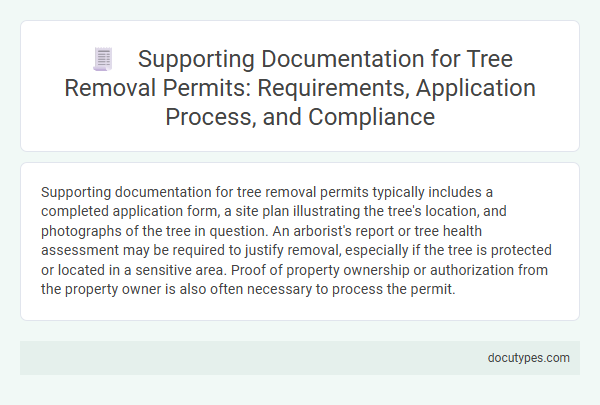Supporting documentation for tree removal permits typically includes a completed application form, a site plan illustrating the tree's location, and photographs of the tree in question. An arborist's report or tree health assessment may be required to justify removal, especially if the tree is protected or located in a sensitive area. Proof of property ownership or authorization from the property owner is also often necessary to process the permit.
Introduction to Tree Removal Permit Documentation
Tree removal permits require specific documentation to ensure compliance with local regulations. These documents typically include an application form, site plans, and proof of property ownership. You must provide accurate and detailed information for a smooth permit approval process.
Understanding Permit Requirements
What supporting documentation is needed for tree removal permits? Understanding permit requirements involves submitting an application with detailed information about the tree species, size, and location. Property owners must also provide proof of ownership and a site plan illustrating the tree's position relative to structures and property lines.
Essential Supporting Documents
Obtaining a tree removal permit requires submitting specific supporting documentation to ensure compliance with local regulations. These essential documents help verify the necessity and safety of the tree removal process.
- Site Plan - A detailed map showing the exact location of the tree(s) to be removed and surrounding structures or vegetation.
- Arborist Report - An expert assessment detailing the health, species, and risk factors associated with the tree.
- Photographs - Clear images of the tree from multiple angles to provide visual evidence supporting the removal request.
Property Ownership Verification
Property ownership verification is a crucial part of obtaining a tree removal permit. This ensures that the applicant has the legal right to make changes on the land where the tree is located.
You must provide official documents such as a property deed or a recent tax statement. These documents confirm ownership and help prevent unauthorized removals. Without this verification, the permit application may be delayed or rejected.
Site Plans and Tree Surveys
Site plans are essential for tree removal permits, providing a detailed layout of the property including the location of existing trees. These plans help authorities assess the impact of removing specific trees on the landscape and local environment.
Tree surveys offer comprehensive information about each tree's species, size, health, and exact position. Your accurate tree survey ensures compliance with local regulations and supports the permit approval process efficiently.
Arborist Reports and Assessments
Obtaining a tree removal permit requires submitting detailed supporting documentation to verify the health and safety risks of the tree. Arborist reports and assessments provide essential information for permit approval.
- Arborist Report - A certified arborist evaluates the tree's condition, species, and maturity to determine if removal is necessary.
- Health Assessment - This assessment identifies diseases, structural defects, or pest infestations compromising the tree's stability.
- Impact Analysis - The report outlines the potential effects on surrounding vegetation, property, and local ecology if the tree is removed.
Environmental Impact Statements
Environmental Impact Statements (EIS) are critical supporting documents required for tree removal permits to assess potential effects on local ecosystems. These statements help permit authorities evaluate the environmental consequences of removing trees in sensitive or protected areas.
- Scope of Impact - The EIS details the extent to which tree removal will affect soil stability, water quality, and wildlife habitats.
- Mitigation Measures - It outlines strategies to minimize adverse environmental effects and promote ecosystem restoration post-removal.
- Regulatory Compliance - The statement ensures proposed removals comply with local, state, and federal environmental regulations.
Submitting a comprehensive Environmental Impact Statement supports informed decision-making and legal compliance during the permit approval process.
Step-by-Step Application Process
| Step | Description | Required Supporting Documents |
|---|---|---|
| 1. Application Submission | Complete and submit the official tree removal permit application form to the local permitting authority. | Completed application form with applicant information and tree details. |
| 2. Site Plan Preparation | Provide a detailed site plan indicating the exact location of the tree(s) to be removed. | Scaled site plan or map showing property boundaries and tree locations. |
| 3. Tree Inventory and Health Assessment | Include a certified arborist report evaluating the health, species, and condition of the tree(s). | Certified arborist's health and risk assessment report. |
| 4. Photographic Evidence | Submit photographs that clearly show the tree(s) targeted for removal. | High-resolution photos from multiple angles of the tree(s) and surrounding area. |
| 5. Justification Statement | Explain the reason for tree removal, such as disease, safety concerns, or development needs. | Written justification letter outlining the necessity for removal. |
| 6. Environmental Impact Assessment (If Required) | Provide assessment results if the removal could affect protected species or ecosystems. | Environmental impact report prepared by qualified professionals. |
| 7. Payment of Fees | Pay the required application processing and inspection fees as specified by the jurisdiction. | Receipt or proof of payment for permit application fees. |
| 8. Review and Approval | Await official review by the permitting authority and provide any additional documents if requested. | Approval letter or denial notice issued by the permit office. |
Compliance with Local Regulations
Obtaining a tree removal permit requires submission of specific supporting documentation to ensure compliance with local regulations. These documents typically include a detailed site plan, proof of property ownership, and an arborist's report assessing the tree's health and impact.
Your application must align with municipal guidelines to avoid delays or denials. Providing accurate and complete documentation demonstrates adherence to environmental and zoning laws governing tree removal.
What Supporting Documentation Is Needed for Tree Removal Permits? Infographic

